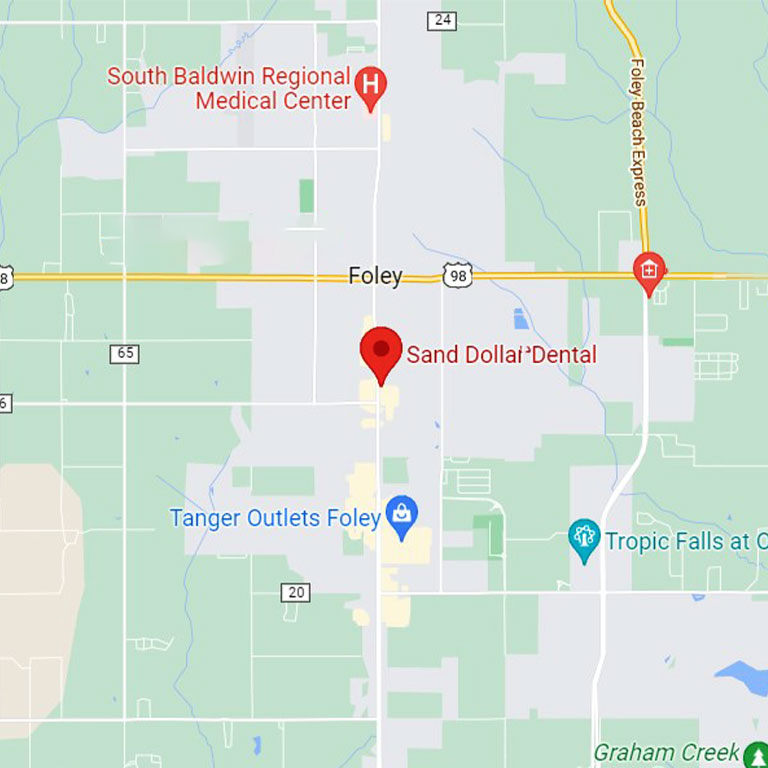Root Canals in Foley, AL
A root canal refers to the procedure that a dentist will use to clean out the damaged pulp of a tooth. This will not only eliminate any bacteria that’s managed to infect the root canal, it will also prevent the tooth from becoming infected again and save the natural structure of the tooth. If you need a root canal, you can expect the inflamed pulp to be carefully cleaned out, before the tooth is disinfected. Finally, the tooth will be filled and sealed.
Patients typically have a lot of questions about root canals, most often because they may have heard some very disturbing myths about the service. Unfortunately, many people will delay coming to the dentist because they’re more worried about the cure than they are the disease.
The Nature of Root Canals in Foley, AL
If you’re wondering what happens during a root canal, you should know that this procedure has been perfected over the decades since it was first introduced. Today, it’s one of the most routine tasks that an endodontist can do, and the discomfort and pain from its completion are typically mild to non-existent.
In fact, a root canal is a proven way to relieve pain without sacrificing the tooth. If you need a root canal to treat a damaged tooth, you can expect the process to make it healthy once again. Unlike the root canals of old, you can expect the process to be more like that of a regular filling. In just one to two appointments, you can get everything back on track. If you want to smile wide and eat what you like again, a root canal can be the answer you’re looking for.
The central benefit of a root canal is that it saves the natural tooth. A reputable dentist will always try to do this whenever and wherever possible. Your teeth are the key to chewing, speaking, and smiling, and saving one will prevent the stress of another. Root canals can restore your teeth for a lifetime, so you won’t have to worry about losing your chompers in the future.
How It Works
Your tooth is made up of enamel on the outside and a hard layer underneath the enamel, known as dentin. Under that is the soft pulp of the tooth, which contains the blood vessels, connective tissue, and nerves. The pulp is what made the root of the tooth possible when it was first developing. As soon as a tooth is done developing, it doesn’t need the pulp of the tooth anymore, because it will receive nourishment from the surrounding tissues of your other teeth.
A root canal typically includes the following steps:
- X-rays: The first step is to see what’s happening inside the tooth. X-rays reveal the extent of the damage, and they confirm that a root canal is the best possible treatment for you.
- Anesthesia: Local anesthesia can be used to numb both the tooth and gums. If you wish, you can also talk to a dentist in Foley, AL, about the possibility of additional medication, such as oral sedatives, to help prevent anxiety during the procedure.
- Dental dam: The dentist will use a rubber dam to keep the tooth separated from the rest of the teeth. The rubber instrument will also keep the tooth dry.
- Opening: The dentist will create a small hole in the crown of the tooth. This is the only way to access the pulp. Dentists use very small instruments to remove the nerves, tissues, and blood vessels inside.
- Cleaning and filling: After the pulp is gone, the canal will need to be further cleaned and disinfected. The dentist will also shape the canal so it can be filled with a flexible material called gutta-percha.
- Sealing: The tooth is sealed with a temporary dental filling, which will keep bacteria from making its way back into the canal.
- Crown: Crowns are typically the last step in the process. These are custom-made materials that can take anywhere from a few hours to a few weeks to make. Once the crown is ready, your temporary filling will be removed and the permanent crown will be placed on top of the tooth.
It can feel like a lot to handle when you read about root canals, but the reality is that root canals move along at a steady pace. A good dentist will have this all down to a science, so you can get in and out without the hassle.
When Do You Need a Root Canal?
Root canals are typically needed when a tooth is either damaged or infected. It’s often because of a deep cavity, a problem with a previous cavity, or a traumatic injury (e.g, car accident, fall, etc). In some cases, genetics can play a role as well.
Here are a few major signs that you may need a root canal:
- Sensitivity: When a tooth is sensitive, particularly to hot or cold foods, this is often a sign that a root canal is needed.
- Pain: Pain while biting or chewing in one area can signify a problem with the nerve.
- Pimples: Pimples on the gums can be a sign of damage to the tooth.
- Swollen gums: The inflammation of the gums may stem from a problem with the tooth.
Talking to your dentist can help you learn a lot about the underlying causes of tooth damage. If you have questions about what constitutes a pimple on the gums or when a tooth hurts enough to warrant an exam, the best thing to do is schedule an appointment to get all the answers.
What to Expect After a Root Canal
The pain after a root canal is typically easy to manage. You’ll typically be numb for the first few hours, in which case you’ll want to avoid eating until the anesthesia wears off. If you do have lingering discomfort, standard over-the-counter painkillers are likely to help or your dentist might also recommend or prescribe a topical solution to place on the affected area. After the root canal, most people are free to return immediately to work or school.
Find a Dentist in Foley, AL
If you need a root canal in Foley, AL, it’s important to choose a staff that can look after you. While the risks of root canals are typically low, they can include everything from reinfection to tooth loss. At Sand Dollar Dental, our experts are here to help you not only understand the procedure, but also to provide the service and care that you need to get your smile back where it should be.


